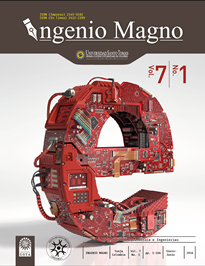Comparison between the subgrade resilient module determined in the laboratory and retrocaculated adjustment factor C
Main Article Content
Abstract
Downloads
Article Details
DECLARATION OF ORGINIALITY OF SUBMITTED ARTICLE
With this document, I/We certify that the article submitted for possible publication in the institutional journal INGENIO MAGNO of the Research Center Alberto Magno CIIAM of the University Santo Tomás, Tunja campus, is entirely of my(our) own writing, and is a product of my(our) direct intellectual contribution to knowledge.
All data and references to completed publications are duly identified with their respective bibliographical entries and in the citations thus highlighted. If any adjustment or correction is needed, I(we) will contact the journal authorities in advance.
Due to that stated above, I(we) declare that the entirety of the submitted material is in accordance with applicable laws regarding intellectual and industrial property, and therefore, I(we) hold myself(ourselves) responsible for any complaint related to it.
If the submitted article is published, I(we) declare that I(we) fully relinquish publishing rights of the article to the University Santo Tomás, Tunja campus. As remuneration for this relinquishment of rights, I(we) declare my(our) agreement to receive two (2) copies of the edition of the journal in which my(our) article appears.
References
Baladi, G., Dawson, T. y Sessions, C., (2009). Pavement subgrade MR design values for Michigan’s seasonal changes, Final Report No RC-1531. Míchigan: Universidad del Estado de Míchigan.
Federal Highway Administration (FHWA). (1997). Design pamphlet for the determination of design subgrade in support of the 1993 AASHTO guide for the design of pavement structures. No FHWA-RD-97-083. Washington: Autor.
Higuera, C. (2010). Caracterización de la resistencia de la subrasante con la información del deflectómetro de impacto. Revista Facultad de Ingeniería Universidad Pedagógica y Tecnológica de Colombia, 29(28), 73-92.
Instituto Mexicano del Transporte (IMT) (1998). Evaluación estructural no destructiva de pavimentos. Sanfandila: Secretaría de Comunicaciones y Transportes.
Monzón, J. (2012). Influencia del comportamiento viscoso de arcillas sobre el módulo resiliente y la deformación permanente de subrasantes (trabajo de grado). Bogotá: Pontificia Universidad Javeriana.
Rivera, J. et al. (2012). Avances en el desarrollo de la metodología para la valoración modular por retrocálculo de capas no ligadas mediante la utilización del light weight deflectometer. XVI Congreso Argentino de Vialidad y Tránsito. Córdoba: Asociación Argentina de la Carretera..
Rohde, G. T. (1994). Determining pavement structural number from FWD testing. Washington: Transportation Research Record.
Urbáez, E. et al. (2004). Estimación del valor “C” incluido en el método AASHTO-93 para el retro-cálculo modular de la sub-rasante. Caso práctico. III Congreso Venezolano del Asfalto. Barquisimeto: COVEAS.

